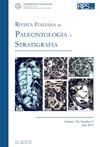日本上新世和更新世灯笼鱼耳石(远骨鱼科)
IF 1.6
3区 地球科学
Q2 GEOLOGY
引用次数: 9
摘要
真菌耳石是近第三系深层沉积物中最常见的耳石化石,沉积深度约为200 m。日本东南部的这类地点尤其丰富。本文描述了冲绳、四国和本州中部上新世晚期至更新世早期的嗜细胞耳石,并回顾了前人的研究成果。这些动物群代表了热带至亚热带动物区系,以软体动物为基础建立了“Kakegawa动物区系”。经耳石鉴定,共有37种属蝇蛆科,1种属新蝇蛆科。公开命名法记录2种,现存常存种23种,灭绝种12种,其中新种7种。新发现的种数为:中国横斑蝶、印度横斑蝶、日本横斑蝶、日本横斑蝶、日本竖斑蝶、日本竖斑蝶。还描述了来自斐济推定的Piacenzian的两个非常大的耳石(bbbb8毫米长),其中一个是新种- Diaphus grebneffi -代表了迄今为止已知的该属中so组物种中最大的耳石。胞菌耳石组合的特点是大量的大标本(长约5毫米),它们肯定来自完全成年的鱼类,是迄今为止北太平洋化石记录中所描述的同类中最大的一个。它的组成被解释为地层学和环境的目的。在加勒比地区发现的一些与同期发现有联系的稀有物种的出现,说明了嗜菌耳石在超区域生物地层学方面的潜力。将化石组合与最近的分布进行比较,支持了由软体动物建立的温暖的“Kakegawa动物群”的概念,同时也证明了某些热带物种在上新世晚期比现在更向北移动。本文章由计算机程序翻译,如有差异,请以英文原文为准。
LANTERNFISH OTOLITHS (TELEOSTEI, MYCTOPHIDAE) FROM THE PLIOCENE AND PLEISTOCENE OF JAPAN
Myctophid otoliths are the most common fossil otoliths to be found in Neogene deep water sediments below approximately 200 m depositional depth. The southeastern part of Japan is particularly rich in such locations. Here we describe myctophid otoliths from late Pliocene to early Pleistocene locations on Okinawa, Shikoku and central Honshu and review previous publications. These faunas represent the tropical to subtropical faunal zone, which was established as the “Kakegawa Fauna” based on molluscs. A total of 37 species are recognized by means of otoliths in the family Myctophidae and one in the family Neoscopelidae. Two species are recorded in open nomenclature, 23 as persistent extant species and 12 extinct species, thereof 7 new. The new species are: Diaphus caurus, Diaphus endoi, Diaphus kakegawaensis, Diaphus nafpaktitisi, Diaphus noboriensis, Symbolophorus moriguchii and Notoscopelus praejaponicus. Two very large myctophid otoliths (>8 mm length) from the putative Piacenzian of Fiji are also described, one being a new species - Diaphus grebneffi - representing the largest by far otolith associated with the So-group of species in the genus so far known. The myctophid otolith assemblage is characterized by an abundance of large specimens (>5 mm length) which certainly derived from fully adult fishes and represents the biggest association of its kind described so far from the fossil record of the northern Pacific. Its composition is interpreted for stratigraphic and environmental purposes. The occurrence of a few, rare species with links to coeval finds in the Caribbean exemplify the potential of myctophid otoliths for supraregional biostratigraphic purposes. The comparison of the fossil assemblage with the distribution in the Recent supports the concept of a warm “Kakegawa Fauna” as established by molluscs and at the same time documents that certain tropical species reached further north during the late Pliocene than they do today.
求助全文
通过发布文献求助,成功后即可免费获取论文全文。
去求助
来源期刊
CiteScore
3.60
自引率
4.30%
发文量
28
审稿时长
>12 weeks
期刊介绍:
The Rivista Italiana di Paleontologia e Stratigrafia was founded in 1895. It publishes original papers dealing with all fields of paleontology and of stratigraphy, from Italy and the Mediterranean to the Tethys, as well across the globe from China to North America.

 求助内容:
求助内容: 应助结果提醒方式:
应助结果提醒方式:


